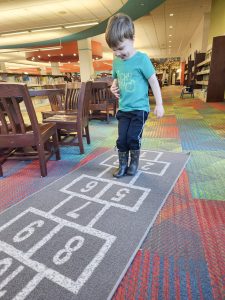 The Library believes that play is wildly important for a child’s development. That’s why we encourage and curate play and activities in the Youth Services department, plan play-based programs like Baby & Me Playtime, and create booklists about play for parents and caregivers.
The Library believes that play is wildly important for a child’s development. That’s why we encourage and curate play and activities in the Youth Services department, plan play-based programs like Baby & Me Playtime, and create booklists about play for parents and caregivers.
But with so many toys to choose from in the world, how do you know what makes a good learning toy? There are lots of ways to evaluate toys—make sure they are age-appropriate, reasonably priced, and that they are appropriate for the child’s home. Here a few things to look for when considering what makes a good early learning toy:
Open-Ended Toys
Blocks, LEGO, Magna-Tiles, and more promote imaginative play and your child can re-invent uses for them as they grow up. As a baby, they might chew on silicone blocks but that can lead to stacking and sorting as a toddler and using them to create an obstacle driving course for their toy cars as a preschooler.
Toys with More Than One Option
Puzzles with chunky pieces are wonderful ways for children to play with. You child can complete the puzzle, name or describe each piece, and if they lose one of the pieces—the chunky pieces can become regular play pieces!
Cooperative Toys
Cooperative toys are ones designed to have more than one participant using them together. Board games and puzzles are some of the most familiar toys to be cooperative, but even a LEGO or train table can help an individual toy become cooperative. Simple games like peek-a-boo and I Spy become cooperative when facilitated by a caregiver or older child too.
Toys That Encourage Movement
Toys that promote movement and activity help a child work on their motor skills, balance, and coordination. This doesn’t always have to be on a trampoline or swing set! For a preschooler, drawing a hopscotch grid with chalk on the sidewalk is a fun way to jump, count, and get outside. For a baby, a ball rolled just out of their reach can encourage them to crawl to get it.
Did you know these are some of the same things the Library looks for when adding toys to our Play Area or programming? You can find examples of all these kinds of toys here at GPL, so stop by and look around!


Add a comment to: What Makes a Good Early Learning Toy?